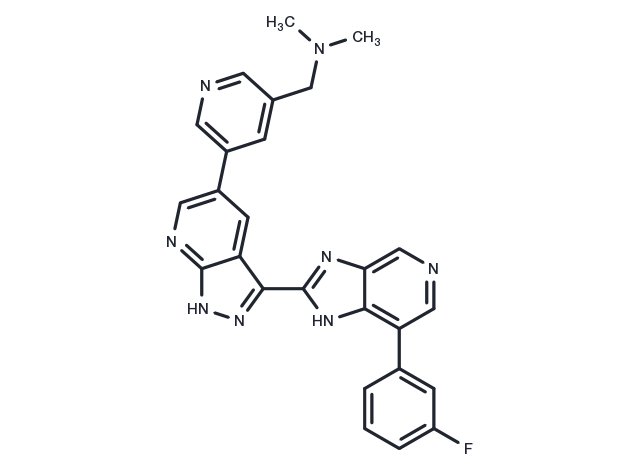Powder: -20°C for 3 years | In solvent: -80°C for 1 year


Ipivivint, a first-in-class, orally active and potent CDC-like kinase (CLK) inhibitor, inhibits CLK1 (IC50=1.4 μM), CLK2 (IC50=0.002 μM) and CLK3 (IC50=0.022 μM). Ipivivint reduces Wnt pathway signaling gene expression through inhibiting CLK activity and serine and arginine rich splicing factor (SRSF) phosphorylation and disrupting spliceosome activity. Ipivivint can be used for the research of cancer[1].

| Pack Size | Availability | Price/USD | Quantity |
|---|---|---|---|
| 25 mg | 6-8 weeks | $ 1,670.00 | |
| 50 mg | 6-8 weeks | $ 2,180.00 | |
| 100 mg | 6-8 weeks | $ 2,800.00 |
| Description | Ipivivint, a first-in-class, orally active and potent CDC-like kinase (CLK) inhibitor, inhibits CLK1 (IC50=1.4 μM), CLK2 (IC50=0.002 μM) and CLK3 (IC50=0.022 μM). Ipivivint reduces Wnt pathway signaling gene expression through inhibiting CLK activity and serine and arginine rich splicing factor (SRSF) phosphorylation and disrupting spliceosome activity. Ipivivint can be used for the research of cancer[1]. |
| Targets&IC50 | CDK3:7 nM (EC50), CDK2:1 nM (EC50) |
| In vitro | Ipivivint (SW480 cells; 0.01~10 μM; 1 hour) potently inhibits SRSF5/6 phosphorylation[1].Ipivivint (SW480 cells; 0.03 μM~3 μM; 48 hour) induced apoptosis[1]..Ipivivint (HEK-293T cells; 0.03 μM~3 μM; 1 hour) inhibits Wnt/β-catenin signaling induced by Wnt3a[1].Ipivivint (SW480 cells; 0.3~10 μM; 6 hour) increases nuclear speckle enlargement[1].Ipivivint (SW480 cells; 0.3~3μM; 24hours) significantly decreases expression of Wnt target genes (AXIN2, LEF1, MYC, and TCF7) and TCF7L2. SM08502 (SW480 cells; 0.03~3μM; 24hours) inhibits cytoplasmic or nuclear fractions protein expression. Ipivivint (NCI-N87 cells) inhibits proliferation[1].Ipivivint strongly inhibits Wnt pathway signaling activity (EC50 = 0.046 μM) in SW480 colon cancer cells[1]. |
| In vivo | Ipivivint (25 mg/kg; p.o.) potently inhibits tumor SRSF6 phosphorylation[1]. |
| Molecular Weight | 464.5 |
| Formula | C26H21FN8 |
| CAS No. | 1481617-15-5 |
Powder: -20°C for 3 years | In solvent: -80°C for 1 year
You can also refer to dose conversion for different animals. More
bottom
Please see Inhibitor Handling Instructions for more frequently ask questions. Topics include: how to prepare stock solutions, how to store products, and cautions on cell-based assays & animal experiments, etc.
Ipivivint 1481617-15-5 inhibitor inhibit
